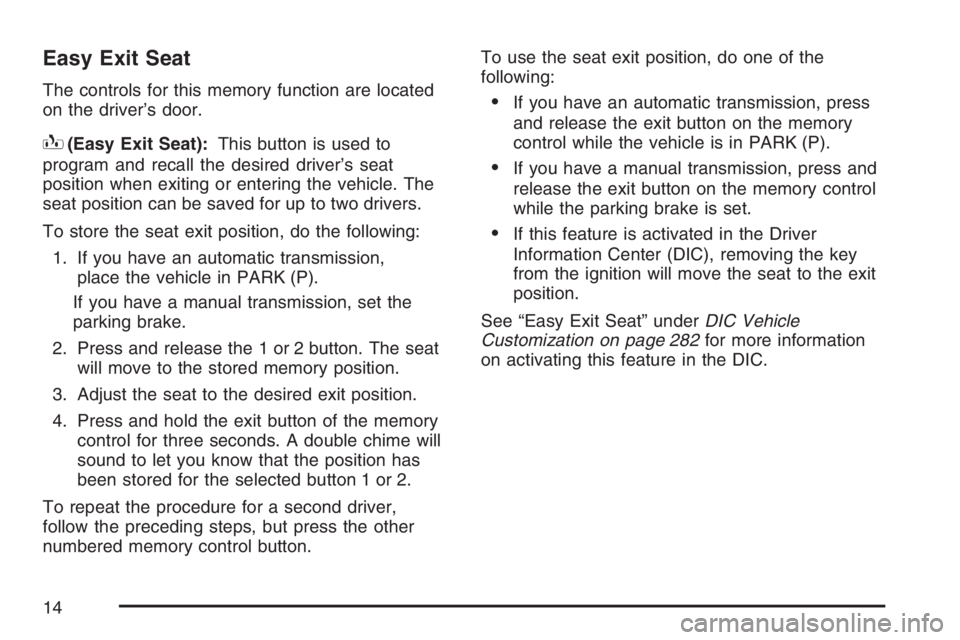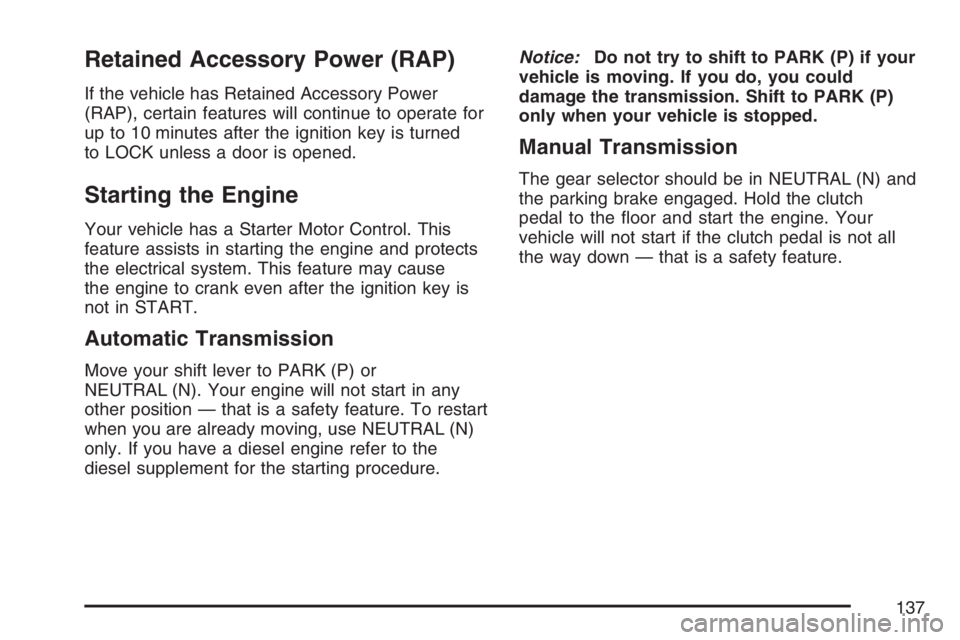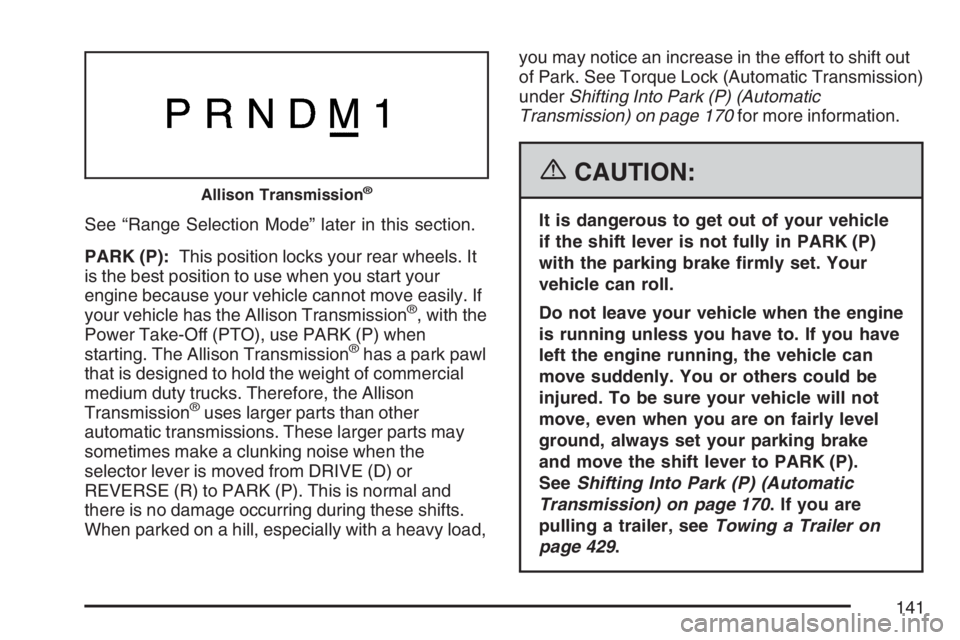2007 GMC SIERRA CLASSIC parking brake
[x] Cancel search: parking brakePage 13 of 674

To store the memory settings, do the following:
1. If you have an automatic transmission, place
the vehicle in PARK (P).
If you have a manual transmission, set the
parking brake.
2. Adjust the driver’s seat, including the seatback
recliner and lumbar, and both outside mirrors
to your preference.
3. Press and hold the 1 or 2 button of the
memory control for three seconds. A
double chime will sound to let you know that
the position has been stored.
To repeat the procedure for a second driver,
follow the preceding steps, but press the other
numbered memory control button.To recall a memory position, do one of the
following:
If you have an automatic transmission, press
and release the desired button 1 or 2 while
the vehicle is in PARK (P). A single chime will
sound and the memory position will be
recalled.
If the vehicle is not in PARK (P), the memory
position will not be recalled.
If you have a manual transmission, press and
release the desired button 1 or 2 while the
parking brake is set. A single chime will sound
and the memory position will be recalled.
If the parking brake is not set, the memory
position will not be recalled.
To stop recall movement of the memory seat
feature at any time, press one of the memory
buttons or power seat controls.
13
Page 14 of 674

Easy Exit Seat
The controls for this memory function are located
on the driver’s door.
B(Easy Exit Seat):This button is used to
program and recall the desired driver’s seat
position when exiting or entering the vehicle. The
seat position can be saved for up to two drivers.
To store the seat exit position, do the following:
1. If you have an automatic transmission,
place the vehicle in PARK (P).
If you have a manual transmission, set the
parking brake.
2. Press and release the 1 or 2 button. The seat
will move to the stored memory position.
3. Adjust the seat to the desired exit position.
4. Press and hold the exit button of the memory
control for three seconds. A double chime will
sound to let you know that the position has
been stored for the selected button 1 or 2.
To repeat the procedure for a second driver,
follow the preceding steps, but press the other
numbered memory control button.To use the seat exit position, do one of the
following:
If you have an automatic transmission, press
and release the exit button on the memory
control while the vehicle is in PARK (P).
If you have a manual transmission, press and
release the exit button on the memory control
while the parking brake is set.
If this feature is activated in the Driver
Information Center (DIC), removing the key
from the ignition will move the seat to the exit
position.
See “Easy Exit Seat” underDIC Vehicle
Customization on page 282for more information
on activating this feature in the DIC.
14
Page 113 of 674

Keys............................................................ 115
Remote Keyless Entry System.................. 116
Remote Keyless Entry System
Operation............................................... 117
Doors and Locks........................................ 120
Door Locks................................................ 120
Power Door Locks..................................... 121
Delayed Locking........................................ 122
Programmable Automatic Door Locks........ 123
Rear Door Security Locks (Crew Cab)....... 126
Lockout Protection..................................... 126
Rear Doors............................................... 126
Tailgate..................................................... 127
Windows...................................................... 129
Manual Windows....................................... 129
Power Windows........................................ 130
Swing-Out Windows.................................. 131
Sliding Rear Window................................. 131
Sun Visors................................................ 131Theft-Deterrent Systems............................. 131
Content Theft-Deterrent............................. 131
Passlock
®.................................................. 133
Starting and Operating Your Vehicle......... 134
New Vehicle Break-In................................ 134
Ignition Positions....................................... 135
Retained Accessory Power (RAP)............. 137
Starting the Engine.................................... 137
Engine Coolant Heater.............................. 139
Automatic Transmission Operation............. 140
Tow/Haul Mode......................................... 147
Manual Transmission Operation................. 149
Four-Wheel Drive...................................... 153
Parking Brake........................................... 169
Shifting Into Park (P)
(Automatic Transmission)....................... 170
Shifting Out of Park (P)
(Automatic Transmission)....................... 172
Parking Over Things That Burn................. 173
Engine Exhaust......................................... 174
Running the Engine While Parked............. 175
Section 2 Features and Controls
113
Page 137 of 674

Retained Accessory Power (RAP)
If the vehicle has Retained Accessory Power
(RAP), certain features will continue to operate for
up to 10 minutes after the ignition key is turned
to LOCK unless a door is opened.
Starting the Engine
Your vehicle has a Starter Motor Control. This
feature assists in starting the engine and protects
the electrical system. This feature may cause
the engine to crank even after the ignition key is
not in START.
Automatic Transmission
Move your shift lever to PARK (P) or
NEUTRAL (N). Your engine will not start in any
other position — that is a safety feature. To restart
when you are already moving, use NEUTRAL (N)
only. If you have a diesel engine refer to the
diesel supplement for the starting procedure.Notice:Do not try to shift to PARK (P) if your
vehicle is moving. If you do, you could
damage the transmission. Shift to PARK (P)
only when your vehicle is stopped.
Manual Transmission
The gear selector should be in NEUTRAL (N) and
the parking brake engaged. Hold the clutch
pedal to the �oor and start the engine. Your
vehicle will not start if the clutch pedal is not all
the way down — that is a safety feature.
137
Page 141 of 674

See “Range Selection Mode” later in this section.
PARK (P):This position locks your rear wheels. It
is the best position to use when you start your
engine because your vehicle cannot move easily. If
your vehicle has the Allison Transmission
®, with the
Power Take-Off (PTO), use PARK (P) when
starting. The Allison Transmission
®has a park pawl
that is designed to hold the weight of commercial
medium duty trucks. Therefore, the Allison
Transmission
®uses larger parts than other
automatic transmissions. These larger parts may
sometimes make a clunking noise when the
selector lever is moved from DRIVE (D) or
REVERSE (R) to PARK (P). This is normal and
there is no damage occurring during these shifts.
When parked on a hill, especially with a heavy load,you may notice an increase in the effort to shift out
of Park. See Torque Lock (Automatic Transmission)
underShifting Into Park (P) (Automatic
Transmission) on page 170for more information.
{CAUTION:
It is dangerous to get out of your vehicle
if the shift lever is not fully in PARK (P)
with the parking brake �rmly set. Your
vehicle can roll.
Do not leave your vehicle when the engine
is running unless you have to. If you have
left the engine running, the vehicle can
move suddenly. You or others could be
injured. To be sure your vehicle will not
move, even when you are on fairly level
ground, always set your parking brake
and move the shift lever to PARK (P).
SeeShifting Into Park (P) (Automatic
Transmission) on page 170. If you are
pulling a trailer, seeTowing a Trailer on
page 429.
Allison Transmission®
141
Page 151 of 674

Also, use REVERSE (R), along with the parking
brake, when turning off your engine and parking
your vehicle.
Five-Speed (VORTEC™ 4.3L V6 and
4.8L V8 Engines)
Here is how to operate your transmission:
FIRST (1):Press the clutch pedal and shift into
FIRST (1). Then, slowly let up on the clutch pedal
as you press the accelerator pedal.
You can shift into FIRST (1) when you are going
less than 20 mph (32 km/h). If you have come to a
complete stop and it is hard to shift into FIRST (1),
put the shift lever into NEUTRAL and let up on
the clutch. Press the clutch pedal back down. Then
shift into FIRST (1).
Notice:If you try to shift down into FIRST (1)
at excessive vehicle speeds, clutch or
engine damage could occur. Do not shift into
FIRST (1) unless you are going less than
20 mph (32km/h).
SECOND (2):Press the clutch pedal as you let
up on the accelerator pedal and shift into
SECOND (2). Then, slowly let up on the clutch
pedal as you press the accelerator pedal.THIRD (3), FOURTH (4) and FIFTH (5):Shift into
THIRD (3), FOURTH (4) and FIFTH (5) the same
way you do for SECOND (2). Slowly let up on the
clutch pedal as you press the accelerator pedal.
To stop, let up on the accelerator pedal and press
the brake pedal. Just before the vehicle stops,
press the clutch pedal and the brake pedal, and
shift to NEUTRAL.
NEUTRAL:Use this position when you start or
idle your engine.
REVERSE (R):To back up, �rst press down the
clutch pedal. Wait for the vehicle to stop moving
and then, shift into REVERSE (R). Let up on
the clutch pedal slowly while pressing the
accelerator pedal.
Notice:Shifting to REVERSE (R) while your
vehicle is moving forward could damage
the transmission. The repairs would not be
covered by your warranty. Shift to
REVERSE (R) only after your vehicle is
stopped.
Also, use REVERSE (R), along with the parking
brake, when turning off your engine and parking
your vehicle.
151
Page 155 of 674

{CAUTION:
Shifting the transfer case to NEUTRAL
can cause your vehicle to roll even if the
transmission is in PARK (P), or if you
have a manual transmission, even if you
are in gear. You or someone else could be
seriously injured. Be sure to set the
parking brake before placing the transfer
case in NEUTRAL. SeeParking Brake on
page 169.
N (Neutral):Shift to this setting only when your
vehicle needs to be towed. SeeRecreational
Vehicle Towing on page 424orTowing Your
Vehicle on page 423.2H (Two-Wheel Drive High):This setting is used
for driving in most street and highway situations.
The front axle is not engaged in two-wheel
drive. This setting also provides the best fuel
economy.
4H (Four-Wheel Drive High):Use this setting
when you need extra traction, such as on snowy or
icy roads or in most off-road situations. This
setting also engages the front axle to help drive
your vehicle. This is the best setting to use
when plowing snow.
You can shift from 2H to 4H or 4H to 2H while the
vehicle is moving. The front axle will engage
faster if you take your foot off of the accelerator
for a couple of seconds after you shift. In
extremely cold weather, it may be necessary to
stop or slow the vehicle to shift into 4H.
155
Page 157 of 674

Shifting In or Out of 4L (Four-Wheel
Drive Low)
Notice:Shifting the transfer case into 4L
while moving at speeds faster than 3 mph
(5 km/h) may cause premature wear to
the transfer case, and may cause the gears to
grind. To avoid causing premature wear,
and grinding the gears, do not shift the transfer
case into 4L while the vehicle is moving
faster than 3 mph (5 km/h).
Shifts into 4L can be made with the vehicle at a
stop, or while slowly rolling about 1 to 3 mph
(2 to 5 km/h).
Shift the automatic transmission into
NEUTRAL (N), or with a manual transmission,
press the clutch pedal, or shift into NEUTRAL.
Shift the transfer case shift lever in one
continuous motion into the 4L position.
When in 4L do not drive faster than 45 mph.
This will reduce wear and extend the life of
the transfer case.
Shifting In or Out of NEUTRAL
1. With the vehicle running and the engine at an
idle set the parking brake and apply the
regular brake.
2. Place the transmission into NEUTRAL (N).
Shift the transfer case in one continuous motion
into or out of the NEUTRAL position.
Automatic Transfer Case
The transfer case
buttons are located to
the left of the instrument
panel cluster.
Use these switches to shift into and out of
four-wheel drive.
157